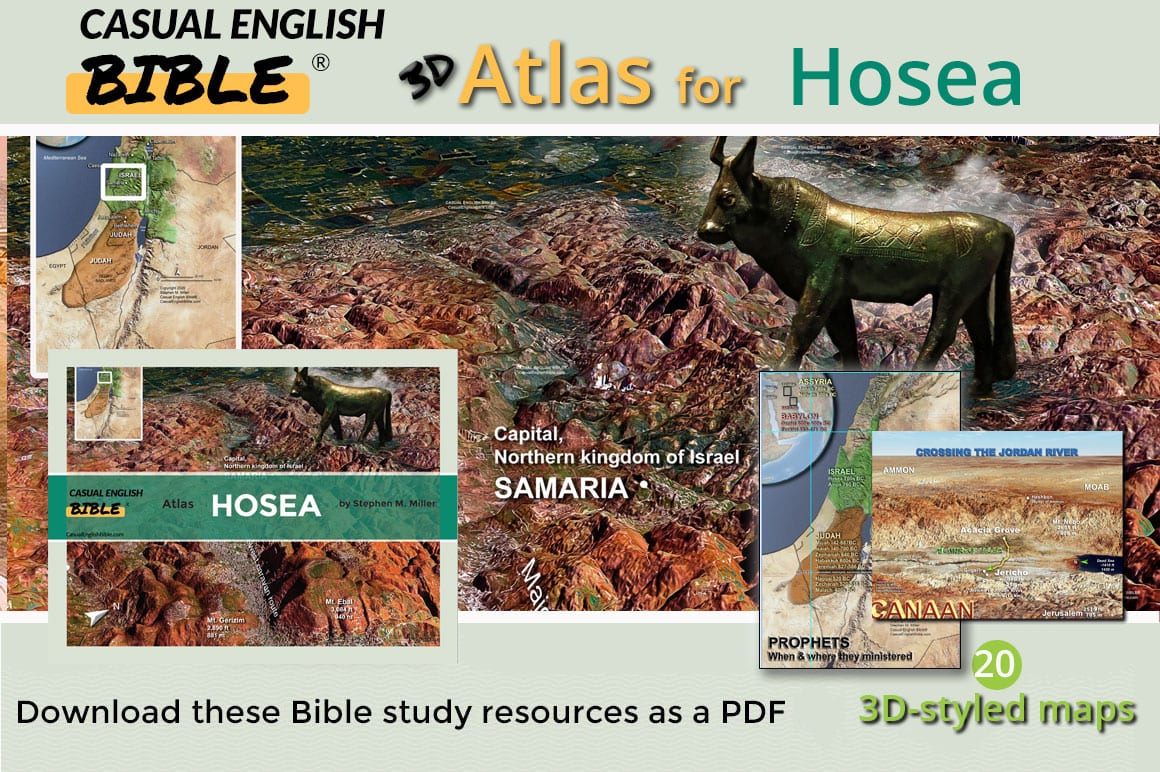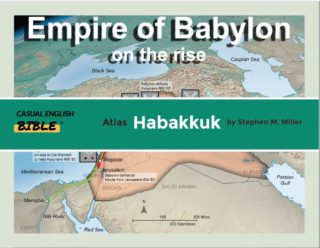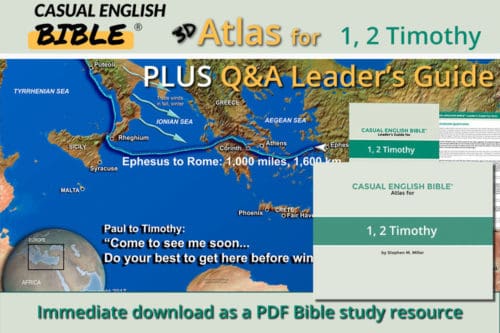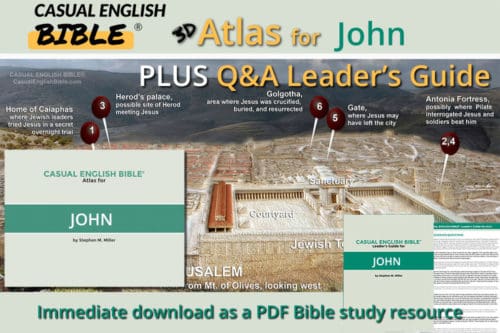Description
Preview
What you get in the Hosea Bible Maps:
- Atlas of 20 high resolution maps about Hosea
- 27 PDF pages of resources
Hosea Bible Maps
The Casual English Bible’s Hosea atlas carefully maps out the life and ministry of one of the strangest prophets in the Bible. Hosea said God told him to marry a hooker of a lady named Gomer. The point was to illustrate Israel’s spiritual prostitution…unfaithfulness to God. They traded God in for a newer model: Baal and other regional gods.
This was either one incredibly over-the-top living parable, or perhaps an experience limited to a vision or a dream Hosea experienced.
Hosea Bible Maps takes readers to each of the sites Hosea talks about when he warns Israel and Judah what’s going to happen to them.
Maps that look like art
Hosea’s beautiful maps include remarkable 3D-style angles that look like stylized photos taken from drones high above the Bible sites.
One maps shows the sacred mountains of Ebal and Gerizim, along with the major caravan trail between the mountains, and on to the city of Samaria, capital of the northern Jewish nation of Israel, which was home to Hosea (see map below).
Hosea Bible maps on the website are low resolution with disgustingly large watermarks. That has a little to do with some folks pulling maps off the website and selling them as their own products.
There are Bible verses that describe people like that. You can find them with Casual English Bible search engine. (Smiling face with crooked teeth.)
Check out each of the maps in atlas.
PDFs of the maps are available in full resolution or optimized for use in mobile devices. People who buy the PDF get both.
INTRO TO HOSEA
Israel was sleeping around on God, committing adultery. Spiritually and physically.
That’s the story Hosea tells. And that’s the story Hosea says he lived—married to a hooker who was apparently unfaithful to him.
Ancestors of today’s Jewish people were worshiping Canaanite fertility gods. And some of the rituals seem to involve sex with pagan priests and worship leaders (see Purpose below).
Perhaps the weirdest thing God asks of anyone in the entire Bible is what he asked of Hosea:
“I want you to find a prostitute and marry her. Then raise the prostitute’s children. Here’s why I want you to do this. The people of your land are unfaithful” (Hosea 1:2).
Real marriage to hooker, or just a scene in a vision?
Scholars can only hope that this marriage and the children that came of it were part of Hosea’s vision, not his life.
But scholars debate what happened there.
If it was just a dream or a vision, it seems odd that Hosea would report the names of the people in his family:
- Gomer, the wife
- Jezreel, the son
- Lo-Ruhamah (means Not Loved), the daughter
- Lo-Ammi (means Not Mine), the other son
Names of the three children were symbols.
Jezreel symbolized that God was going to end King Jehu’s dynasty because of the mass murder they committed at the village of Jezreel (2 Kings 9—10).
Names of the other two children reflected God’s attitude toward Israel’s betrayal—and were perhaps the worst possible names any human being could give to a kid.
Maybe Hosea, at least privately, shortened them into nicknames: Loved and Mine.
Israel’s sin
For the sake of prosperity, people traded God in for handmade golden idols and stone figurines. They expected these sacred objects to give them bumper crops, more children, and lots of healthy livestock.
For the sake of national security, they trusted in alliances with Egypt and Assyria instead of trusting God. With God exiled from the minds and hearts of the Jews, Assyrian soldiers would come to exile the Jews from Israel.
WRITER
Hosea likely wrote these 14 chapters of prophecy or was at least the primary source for some other writer. There’s wide agreement on that among Old Testament scholars.
TIMELINE
Hosea ministered from about 750 BC until Assyrians overran Israel in 722 BC. They deported the people and annexed the land as a province of the empire.
LOCATION
Hosea lived in the northern Jewish kingdom of Israel. Samaria was its capital city, near the sacred mountains of Gerizim and Ebal.
PURPOSE
It seems Hosea had two main concerns:
—Warn Israel that Assyria was going to conquer them, take the land, and exile the people—because of Israel’s sin. Too late to avoid that.
—Assure them that afterward, Israel would return to God and he would take them home.
It was too late for Israel to save itself, by the time Hosea showed up. So, it doesn’t seem that he intended to point them away from danger. They had already set in motion the consequences of their sins.
“Like the siege of beautiful Tyre,
There’ll be a siege in Ephraim,* too.
Then parents will lead their children
Outside the walls, to the slaughter” (Hosea 9:13).
*“Ephraim” is a nickname for Israel, named after the dominant tribe.
It seems Hosea wanted to explain why Assyrian invaders would erase Israel from the political map. Assyrians were coming mainly because Israel gave up on God. They turned to fake fertility gods, chiseled from stone, carved from wood, or molded with gold.
WORSHIPING THE POPULAR GOD: BAAL
Baal was a popular god in the region. For many, he was the top god of fertility in family, fields, and flocks. Canaanites, who were native to what is now Israel and Palestinian land, worshiped Baal.
Joshua, perhaps seven centuries before Hosea, led the Israelite ancestors of Jews in killing many Canaanites. They did this so Jews could reclaim the land the Bible says God promised them, as descendants of Abraham. But Jews continued to worship Baal and other Middle Eastern gods off and on throughout Old Testament times.
ANCIENT PAGAN RAIN DANCE
Some scholars say one worship ritual involved entertaining Baal by making him a voyeur who watched people have sex.
Sex, essentially, was a rain dance.
It’s a tad gross, but some taught the rain was Baal’s semen. So, if the sex of worshipers got Baal stimulated enough, he would make it rain.
In this predominately dry part of the world, the lack of rain is what made him such a sought-after god. For some, the sex would have been a bonus.
It seems that some Jews who worshiped God doubled up and worshiped Baal and other gods, too.
THE PURPOSE, IN 50 WORDS OR LESS
—Hosea wanted to get Israel’s sins on the record before Assyrians, in 722 BC, took the land and then deported the Jews into exile.
—He also wrote to assure the people that the end of Israel wouldn’t be the end of the Jews.
He says that after Israel suffers through the consequences of their bad decisions—including their betrayal of God—their descendants will return to the land.
“My people will live again
In the shade of my wings…
I humbled you once,
But I’ll bless you now” (Hosea 14:7-8).
In addition to the Hosea Bible Atlas
You might consider the atlas for
Best resource for comparing other Bible translations: Bible Gateway. This isn’t an ad. It’s a recommendation from the Casual English Bible.
To support the work of paraphrasing the Casual English Bible and keeping it free online:







